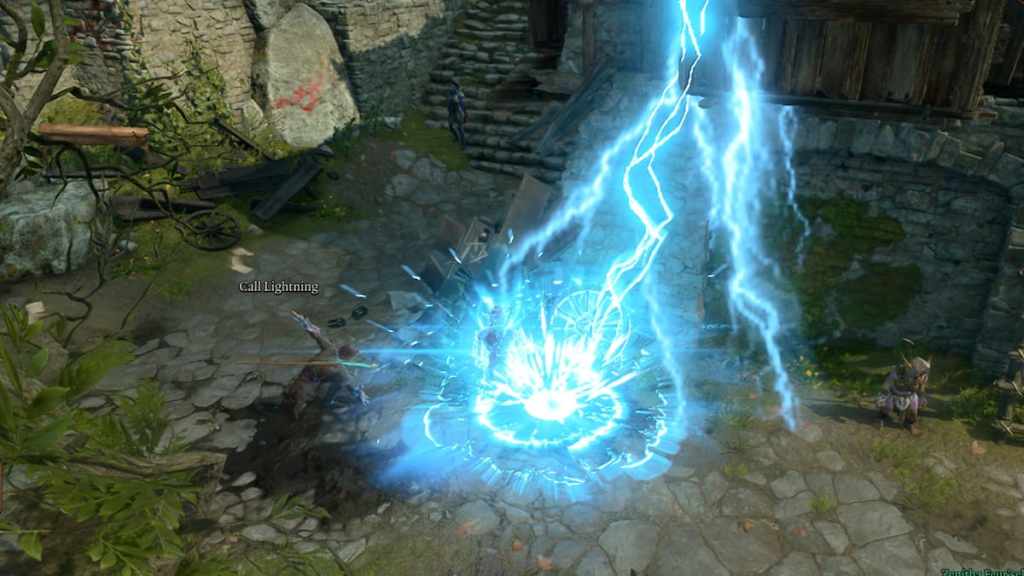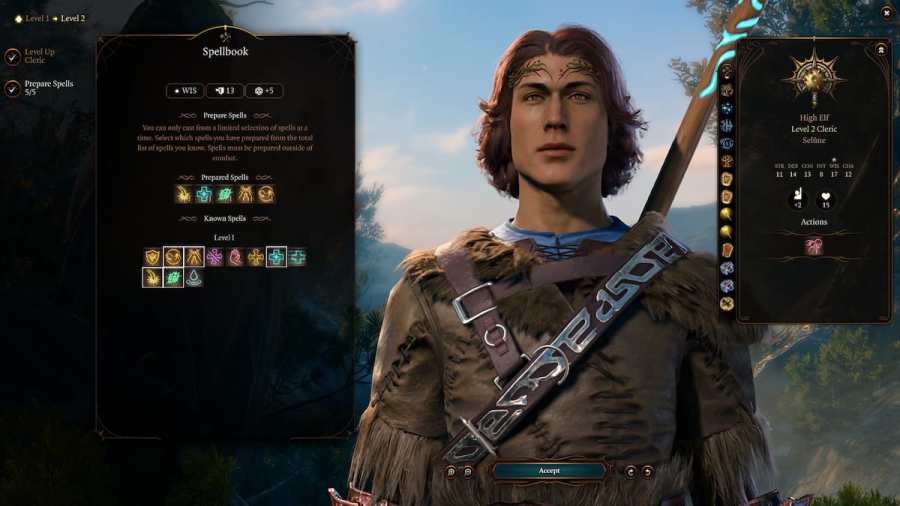Of the twelve classes found in Baldur’s Gate 3, the Cleric might be the most versatile of all. Their ability to switch their whole list of spells in between fights makes them able to heal, control crowds, or dish out tons of damage (depending on the chosen loadout), while their medium armor and shield proficiency makes them able to tank and engage dangerous foes in melee combat. But with so many options, what is the best way to build a Cleric in BG3?
Best Cleric deities in Baldur’s Gate 3

Since the magic abilities of a Cleric depend on which deity they serve, the first major choice we have to make is our domain. This path will define the type of role your Cleric will play in the party and will determine where you need to put your attribute points.
- The Knowledge Domain Cleric is a utility-based subclass with a few extra spells from the Wizard's list. By choosing this domain, you learn two extra languages and gain two more skill proficiencies, on which you will have Expertise (double proficiency bonus). Overall, this makes this subclass ideal for dialogue and exploration, as you are likely to pass most of the Arcana, History, and Investigation checks the game throws at you.
- The Life Domain Cleric is the healer archetype by defect. With skills like Preserved Life and Blessed Healer, this Cleric maximizes the amount of hitpoints it can restore in combat. The extra spells given by the domain are also healing-themed, like Cure Wounds, Aid, and Lesser Restoration. I find this subclass to be really effective on a side character, yet somewhat boring for your main one.
- The Light Domain Cleric is an offensive-oriented subclass with powers of light and fire. With access to spells like Burning Hands, Scorching Ray, and Fireball, it is an ideal class for crowd control and AOE damage. It also has access to blinding abilities like Warding Fire, which can give you the edge when you are in hand-to-hand combat against several enemies.
- The Nature Domain Cleric is almost a Druid without the wildshapes. It gives us the possibility to charm plants and animals and grants us some Druid spells such as Thornwhip, Speak with Animals, Sleet Storm, and Grasping Vine, among others. On top of that, it gives proficiency with Heavy Armor, which can make our character very hard to hit with weapon attacks.
- The Tempest Domain Cleric is my personal favorite. It is an amazing fighter due to its Heavy Armor proficiency, and if you are looking for a Spellcaster who can jump into the fray, become surrounded by enemies, and shred them all to pieces, this is the subclass for you. Their feature Wrath of the Storm allows you to retaliate against an enemy that attacked you and use your reaction to deal them lightning or thunder damage.
- The Trickery Domain Cleric is an enchanter stealth-oriented spellcaster (this is Shadowheart's subclass). With magic abilities like Blessing of the Trickster, Pass Without Trace, and Disguise Self, the domain gives the right tools to build a silent, slippery Cleric. The extra spells like Charm Person, Bestow Curse, and Fear are meant to toy with the minds of your enemies.
- The War Domain Cleric is an excellent melee combatant. You gain Heavy Armor and proficiency in one Martial Weapon of your choice, allowing for more versatility. You can also use your War Priest charges to take extra attacks on your bonus actions. The Divine Favour and Shield of Faith features expand on the effectiveness of the melee build.
Related: BG3 Necromancer Warlock Build Guide
Best Cleric skills and attributes in BG3
When it comes to the allocation of your attribute points, Wisdom is going to be the priority for every Cleric; this is their spellcasting ability and will also make them perceptive and insightful for dialogue purposes.
For the other attributes, it depends on which Domain you chose or what style of play you want. I chose to play a Tempest Domain Cleric, and I would like to fight in melee and wear Heavy Armor. Hence, I put more points in Strength rather than in Dexterity; Strength allows me to hit more consistently with Morningstars and Warhammers, and Dexterity would be nullified by the armor anyways.
If instead of using Heavy Armor, you would like to play a ranged Cleric, a few points in Dexterity can improve your AC and allow you to save against Area Of Effect spells such as Burning Hands or Faerie Fire. Just remember if you are going to be using medium armor, going above +2 in this attribute wouldn’t be of much use.
Next, we need to invest in Constitution to improve our chances of succeeding Concentration checks and boosting our overall HP. I even chose the War Caster feat at level 4 to gain advantage on Concentration checks.
Finally, Charisma and Intelligence are not useful attributes for this class, so you can dump them to 8 (-1). However, there is an argument to be made when the Cleric is your main character, that some Charisma could be useful in certain dialogues.
For my Tempest Cleric build, the attributes looked like this:
| STR | DEX | CON | INT | WIS | CHA |
|---|---|---|---|---|---|
| 14 (+2) | 12 (+1) | 14 (+2) | 8 (-1) | 16 (+3) | 12 (+1) |
Bonus Tip: Later in the game, I used the Potion of Everlasting Vigour (found in Act 2) to permanently increase my Cleric's Strength by 2 (+1); that extra point not only made me better at saving throws but also allowed me to increase the hit rate chances and deal a little extra damage.
Best backgrounds for Cleric in BG3
The background allows you to choose two more skill proficiencies for your character. The Cleric class already makes you choose two from History, Insight, Medicine, Persuasion, and Religion. So, unless you have a particular backstory in mind, I generally choose the background to complement the skills from the class.
For my first Cleric playthrough, I chose the background Acolyte to get the Insight and Religion proficiencies, which are both Wisdom-based and simplified my Cleric skills choice to Insight and Persuasion. Ultimately, it depends on what type of character you want to play and what approach you will take on the game's choices.
Best races for Cleric in BG3

In Baldur's Gate 3, any race grants a +2 increase in one ability and a +1 in another, with no restrictions at all. Therefore, the choice of race does not depend on the attributes but on the racial features or benefits they can provide.
- Dwarves make excellent Clerics. They gain the Battleaxe and Warhammer proficiencies and resistance to Poison. The Duergar subrace also gains advantage against illusions or being Charmed and Paralysed.
- A High-elf is a good match for the cleric because of the extra cantrip and the elf weapon training to gain proficiency in Longbows.
- Gnomes are particularly resistant against magic effects, with advantage on Intelligence, Wisdom and Charisma saving throws. Besides, Rock Gnomes make for good Knowledge Domain Clerics, while Deep Gnomes are great for stealth builds.
Best Cleric cantrips in Baldur's Gate 3
Below are the best cantrips you can use for your cleric:
- Sacred Flame is the Cleric cantrip by excellency. It is a reliable source of Radiant damage, a type of damage that is not easy to come by but can be really useful against undead and some of the enemies of Act 2. Being a Save-Throw-based spell, it allows you to hit highly armored enemies with more consistency.
- Guidance is the most useful cantrip for dialogue situations. Having a 1d4 steady boost to every ability check can allow you to talk your way through difficult encounters or even lockpick and disarm chests with less savescumming.
- Resistance is just like Guidance but for Saving Throws. This is useful before jumping over exploding lava or disarming a dangerous trap, or it could even be used before combat against enemies that proc a lot of Saving Throws, such as the Shadows' Strength Drain or the Harpies' Luring Song.
Related: Baldur’s Gate 3 Ranger Build Guide – Best Stats and Subclass
Level progression for Clerics in BG3
Here is my progression for the Tempest Domain Cleric. The list of prepared spells isn't really important since you can change them in between fights. I made a list of recommended spells, but feel free to change it according to the map locations and your preferred playstyle.
| Level | Subclass Features | Suggestions for Spells |
|---|---|---|
| 1 | Heavy Armor Proficiency Martial Weapon Proficiency Wrath of The Storm Thunderwave Fog Cloud | Guiding Bolt Bane Bless Healing Word |
| 2 | Channel Divinity: Destructive Wrath Channel Divinity: Turn Undead | Protection from Evil and Good |
| 3 | Shatter Gust of Wind | Enhance Ability Spiritual Weapon |
| 4 | Feat: War Caster New cantrip: Thaumaturgy | Calm Emotions Hold Person |
| 5 | Destroy Undead Call Lightning Sleet Storm | Spirit Guardians (a must) Bestow Curse |
| 6 | Thunderbolt Strike | Animate Dead Mass Healing Word |
| 7 | Ice Storm Freedom of Movement | Banishment |
| 8 | Ability Score Improvement: Wisdom +2 Divine Strike: Thunder | Guardian of Faith |
| 9 | Insect Plague Destructive Wave | Dispel Evil and Good |
| 10 | Divine Intervention New Cantrip: Produce Flame | Contagion |
| 11 | - | Planar Ally |
| 12 | Ability Score Improvement: Wisdom +2 | Heroes' Feast |
BG3 Best Cleric multiclass builds

Baldur’s Gate 3 allows players to multiclass without any restriction, allowing for exotic combinations of classes, levels, and skills. However, in many cases, this will lead to a MAD character (not in the sense of insane, but Multi Ability Dependant) who is competent at many things but master at none. There are three popular multiclass options for the Cleric, and as I went over them all, I analyzed their viability.
Cleric Druid multiclass
Clerics and Druids are both spellcasting classes that use Wisdom as a primary attribute. This means you won’t have to stretch thin by investing in too many attributes, and you can focus on Wisdom, Dexterity, and Constitution as your main three.
Despite Clerics and Druids sharing many spells from their list, Clerics can benefit from a 2-level dip into Druid to grab the Wild Shape option. The true broken multiclass is the other way around: a Circle of Spore Druid focused on summoning magic with a dip of 2 levels in Cleric to heal and buff their minions.
Cleric Ranger multiclass
The Ranger is another class that uses Wisdom as their primary casting ability. Mixing the Cleric with this class grants access to Extra Attacks once you get Ranger level 5 while also accessing the spell Hunter's Mark and possibly an animal companion.
Cleric Monk multiclass
Despite Cleric and Monk seeming to be a good combination of classes since they both prioritize Wisdom and Dexterity, this is one of the cases where the multiclass may not be ideal. It is worth considering the case because, at first sight, it seems logical. But nothing the Monk does is really improved by having levels in Cleric. In fact, it only takes away the possibility of having more Ki points. The same happens the other way around, with the Cleric not being able to extract much from the unarmed combat and unarmed defense of the Monk.
Overall, the Cleric is a solid class on its own, and even though multiclasses can be fun, it is hard to beat the power of a full Cleric.
For more on Baldur's Gate 3, check out Baldur’s Gate 3 Finesse Weapons Guide on Pro Game Guides.
